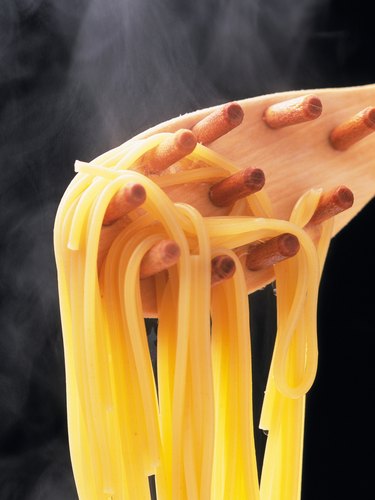
Cooking perfect spaghetti is not difficult, but it does require some attention and precision. You might also have to unlearn some common mistakes that can compromise the quality of a pasta dish. Learn these tips and you will know the secret of perfectly cooked pasta that doesn't stick to itself or the pan.
Traditional Method
Video of the Day
Start with a large pot. Without enough room to grow, pasta will become sticky or gummy. The Smithsonian's recommendation for one pound of pasta is a 6- to 8-quart pot filled with 4 to 5 quarts of water. Bring the water to a rolling boil. It's essential to place spaghetti in very hot water and also to quickly bring the cooking water back to a full boil, says DeLallo.com. To do this, cover the pot after stirring in the spaghetti. When it returns to a boil, remove the lid and stir again. Stirring often, especially in the first few minutes of cooking, keeps the noodles from sticking to each other or the pot.
Video of the Day
The Salt Effect
In the traditional method, you cook pasta in heavily salted water to enhance flavor from the inside. DeLallo.com recommends 2 tablespoons of coarse salt or 1/4 cup of table salt. You can use less if you are on a low-sodium diet. Skipping it all together could lead to less flavorful spaghetti, but it will not affect the texture or make it sticky. The idea that salt is used to make the water boil faster has also been discredited; adding salt makes only a negligible difference in that regard.
Draining the Spaghetti
Start tasting the noodles at 15- to 20-second intervals a few minutes before the recommended cook time. Drain when they reach desired texture, which should be just a little undercooked, or al dente. Reserve some of the starchy cooking water to add to your sauce; it will add flavor and also help bind the sauce to the pasta. Do not rinse the spaghetti after you drain it; this washes away the starchiness on the surface of the noodle. It is this starchiness that helps the sauce cling to it. For this reason, you also should not coat the noodles with oil or even add oil to the cooking pot. While oil prevents the pasta from sticking, it does so only at a price: Your sauce will also slide right off the spaghetti. This is relevant, however, only if you are using a non-oil-based sauce.
Adding Sauce
Photographs of your food might look prettier if you place a large scoop of sauce on top, but your dish will taste better if you mix sauce and pasta together. This mixing allows the flavors to blend. You can help your spaghetti soak up even more flavor by letting it cook a few minutes in the sauce. Drain the noodles 4 minutes before the recommended cook time. Then add them to sauce set at a low simmer for an additional 2 or 3 minutes.